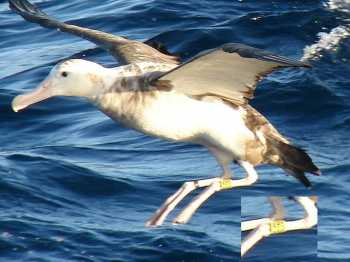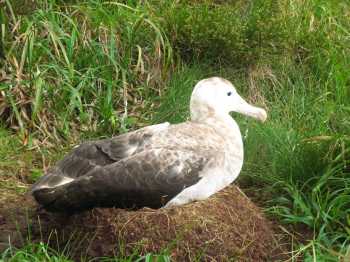Hot on the heels of the news of a colour-banded Tristan Albatross Diomedea dabbenena from Gough Island photographed in Uruguayan waters (click here), a report of two colour-banded birds off South Africa on the other side of the South Atlantic has now been published in the magazine Africa - Birds & Birding.
The two Tristan Albatrosses (A95, a female and C70, a male) are part of the same demographic study in Gonydale on Gough as the Uruguayan bird. They were photographed together (with at least 14 other Tristan Albatross-like birds) scavenging from behind a long-liner off the Atlantic coast of South Africa, close to the Namibian border on 6 August 2009 at 30 27S, 11 57E. A95 had also been spotted a week earlier on 31 July 2009 at 30 31S, 13 17E within South Africa's Exclusive Economic Zone. The two birds were colour-banded as incubating adults in February 2007, when the planned long-term study was initiated.
The longliner was deploying two bird-scaring streamer lines and setting only at night with added weights near the hooks, so thankfully caught none of the birds.
At the time the birds were seen, C70 was rearing a chick on Gough Island, confirming that the Critically Endangered Tristan Albatross can forage far away from its breeding grounds when chick-rearing. In fact, this record extends the at-sea distribution of breeding birds mapped by Cuthbert et al. (2005) using satellite-tracking data.


Thanks to Marienne de Villiers and Meidad Goren for information and for the use of their photographs of A95 (similar pictures of C70 have been published by Goren & Ryan 2010). Research on Tristan Albatrosses at Gough Island is conducted with the approval of the Tristan Conservation Department and with the logistic support of the South African National Antarctic Programme of the Department of Environmental Affairs. It is co-managed by the Percy FitzPatrick Institute, University of Cape Town, South Africa and the UK's Royal Society for the Protection of Birds, and currently receives funds from the UK Goverment's Overseas Territories Environment Programme .
References:
CUTHBERT, R.[J.], HILTON, G.[M.], RYAN, P.[G.] & TUCK, G.N. 2005. At-sea distribution of breeding Tristan Albatrosses Diomedea dabbenena and potential interactions with pelagic longline fishing in the South Atlantic Ocean. Biological Conservation 121: 345-355. (click here).
GOREN, M. & RYAN, P.[G.] 2010. Tristan Albatrosses off South Africa. Africa - Birds & Birding 15(5): 14.
John Cooper, ACAP Information Officer, 17 October 2010

 English
English  Français
Français  Español
Español